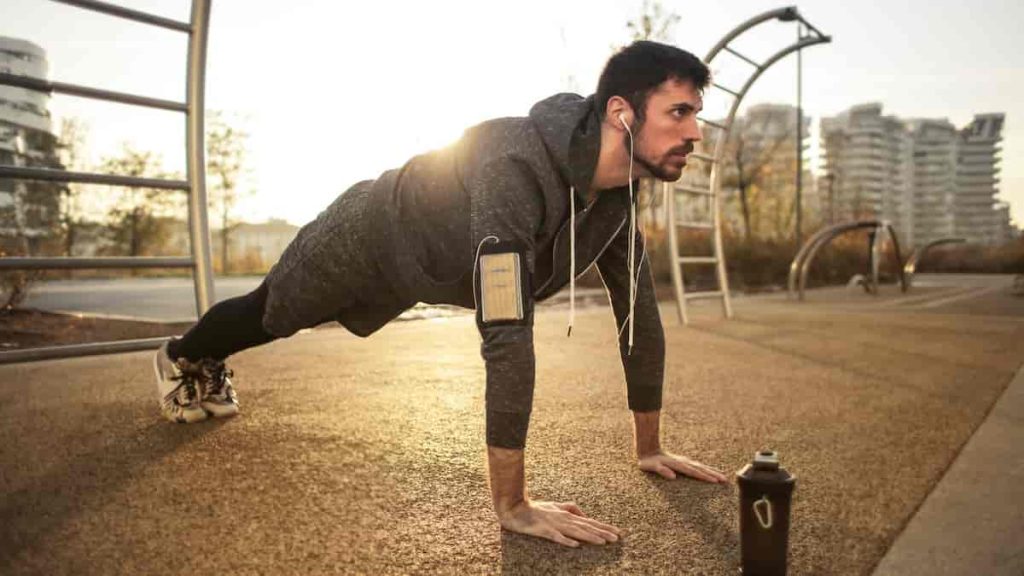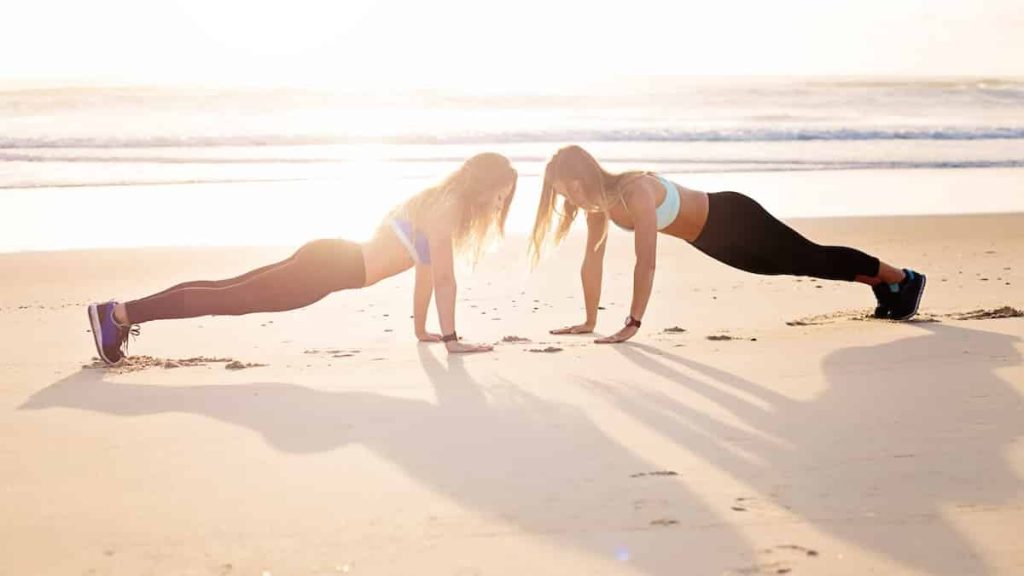Here is your complete guide to push ups workout for chest.
Introduction To Push Ups Workout for Chest
Push-ups are a versatile and effective exercise for developing chest muscles. They offer numerous benefits, such as increasing upper body strength, enhancing muscular endurance, and engaging multiple muscle groups simultaneously. In this article, we will explore the proper technique for performing push-ups, different variations to target specific areas of the chest, an effective push-up workout routine, and address common FAQs about push-ups for chest development. So what you need to know about the push ups workout for chest. Here is your complete guide to push ups workout for chest. So let’s explore step by step the benefits of push ups workout for chest.
Benefits of Push-Ups for Chest
Increased Upper Body Strength
Push-ups engage the chest muscles, along with the shoulders, triceps, and core. Regularly incorporating push-ups into your workout routine can lead to improved upper body strength.
Enhanced Muscular Endurance
Push-ups require sustaining tension in the chest muscles for an extended period, leading to increased muscular endurance over time.
Convenience and Accessibility
Push-ups can be performed anywhere, as they require no equipment. They are a convenient exercise option for individuals who don’t have access to a gym or equipment.
Engaging Multiple Muscle Groups
Push-ups not only target the chest muscles but also engage the shoulders, triceps, and core. This makes them a compound exercise that works several muscle groups simultaneously.
Proper Push-Up Technique

To maximize the effectiveness of push-ups and prevent injury, it’s essential to maintain proper form:
- Starting Position: Begin in a plank position with your hands slightly wider than shoulder-width apart and aligned with your chest.
- Hand Placement and Width: Adjust your hand placement based on comfort and shoulder mobility. Wider hand placement targets the chest muscles, while narrower hand placement emphasizes the triceps.
- Elbow Position and Alignment: Keep your elbows tucked in at approximately a 45-degree angle to your body throughout the movement.
- Body Alignment and Core Engagement: Maintain a straight line from your head to your heels, engaging your core muscles to stabilize your body.
- Breathing Technique: Inhale as you lower your body towards the ground, and exhale as you push back up to the starting position.
- Common Mistakes to Avoid: Avoid sagging or arching your back, flaring your elbows outwards, or only performing partial range of motion during push-ups.
Variations of Push-Ups for Chest
Incorporating different push-up variations can target specific areas of the chest and add variety to your workout routine. Some notable variations include:
- Wide Grip Push-Ups: Placing your hands wider than shoulder-width apart emphasizes the outer chest muscles.
- Close Grip Push-Ups: Bringing your hands closer together targets the inner chest muscles and triceps.
- Decline Push-Ups: Elevating your feet on a stable platform shifts more bodyweight onto the upper chest muscles.
- Incline Push-Ups: Placing your hands on an elevated surface targets the lower chest muscles.
- Diamond Push-Ups: Forming a diamond shape with your hands focuses on the triceps and inner chest muscles.
- Plyometric Push-Ups: Incorporating explosive movements into push-ups helps develop power and explosiveness in the chest muscles.
- One-Arm Push-Ups: Performing push-ups with one hand on the ground challenges stability and engages the chest muscles asymmetrically.
- Archer Push-Ups: Alternating between leaning more weight on one side and shifting to the other targets the chest muscles and builds stability.
- Medicine Ball Push-Ups: Placing one or both hands on medicine balls increases instability and engages additional stabilizing muscles.
- Clapping Push-Ups: Adding a clap during the push-up phase requires explosive power and increases chest muscle activation.
Push-Up Workout Routine for Chest
A well-structured push-up workout routine can help you progress and achieve your chest development goals. Here’s a sample routine that caters to different fitness levels:
Warm-up Exercises
Before starting your push-up workout, perform a brief warm-up to increase blood flow and prepare your muscles:
- Arm Circles: Stand with your feet shoulder-width apart and extend your arms out to the sides. Make small circles with your arms, gradually increasing the size and speed for 30 seconds.
- Shoulder Taps: Assume a plank position and touch your opposite hand to the opposite shoulder. Alternate sides for 10-15 reps on each side.
- Chest Opener Stretch: Stand near a doorway and place your forearm on the door frame with your elbow at a 90-degree angle. Step forward to stretch your chest muscles. Hold for 15-30 seconds on each side.
Beginner Level Routine
Perform 2-3 sets of each exercise, with 30-60 seconds of rest between sets:
- Wide Grip Push-Ups: 8-10 reps
- Incline Push-Ups: 8-10 reps
- Knee Push-Ups: 8-10 reps
- Rest: 60 seconds
Intermediate Level Routine
Perform 3-4 sets of each exercise, with 30-60 seconds of rest between sets:
- Decline Push-Ups: 8-10 reps
- Diamond Push-Ups: 8-10 reps
- Wide Grip Push-Ups: 8-10 reps
- Rest: 60 seconds
Advanced Level Routine
Perform 4-5 sets of each exercise, with 30-60 seconds of rest between sets:
- One-Arm Push-Ups: 4-6 reps on each side
- Plyometric Push-Ups: 8-10 reps
- Close Grip Push-Ups: 8-10 reps
- Rest: 60 seconds

Tips for Maximizing Chest Engagement During Push-Ups
To optimize your push-up workouts and chest muscle development, consider the following tips:
- Focus on Mind-Muscle Connection: Concentrate on engaging and activating your chest muscles during each push-up repetition.
- Slow and Controlled Movements: Perform push-ups with controlled eccentric (downward) and concentric (upward) phases to maximize muscle engagement and prevent momentum-based movements.
- Full Range of Motion: Aim to lower your chest as close to the ground as possible without compromising proper form.
- Incorporating Isometric Holds: Pause at the bottom position of the push-up for a few seconds to increase time under tension and enhance muscle activation.
- Using Resistance Bands or Weighted Vests: Add resistance to your push-ups by incorporating resistance bands or wearing weighted vests to intensify the workout and stimulate muscle growth.
Common FAQs About Push Ups Workout for Chest
How many push-ups should I do for chest development?
The number of push-ups you should do depends on your fitness level and goals. Gradually increase the number of repetitions or sets over time to challenge your chest muscles and promote growth.
Can push-ups alone build a bigger chest?
Push-ups are an effective exercise for chest development, but for substantial muscle growth, incorporating additional chest exercises and progressive overload principles is recommended.
Is it necessary to do push-ups every day?
Allowing proper rest and recovery is essential for muscle growth. Aim for 2-3 push-up workouts per week, with at least one day of rest between sessions.
Can push-ups cause shoulder pain?
Push-ups can strain the shoulders if performed with improper form or if you have pre-existing shoulder issues. It’s crucial to maintain proper technique and modify the exercise if necessary.
Can push-ups help reduce chest fat?
Push-ups primarily target chest muscles and do not specifically target fat reduction. However, incorporating push-ups into a well-rounded exercise routine that includes cardio and a balanced diet can contribute to overall fat loss.
Should I do push-ups before or after weightlifting?
The order of exercises depends on your goals. If your focus is on developing chest muscles, perform push-ups before weightlifting to prioritize chest activation. However, if strength training is your main objective, perform push-ups after weightlifting.
Are there any alternatives to push-ups for chest development?
Yes, alternative exercises such as dumbbell bench press, cable chest flyes, and chest press machines can also target the chest muscles effectively.
Can women benefit from push-ups for chest muscles?
Absolutely! Push-ups are beneficial for both men and women in developing chest muscles, increasing upper body strength, and improving overall fitness.
What should I do if I can’t do a full push-up?
If you struggle with full push-ups, start with modified variations such as knee push-ups or incline push-ups. Gradually progress to full push-ups as you build strength and improve form.
Can push-ups build chest?
Yes, push-ups can effectively build chest muscles. Push-ups primarily target the pectoralis major, the main muscle group in the chest. By performing push-ups with proper form and gradually increasing the intensity and difficulty, you can stimulate muscle growth and development in the chest.
Read More About What is The Benefit of Papaya.
How many push-ups a day for a chest?
The number of push-ups you should do for chest development depends on your fitness level and goals. It is recommended to start with a number that challenges you without compromising form. Aim for 2-3 sets of push-ups, with 8-15 repetitions in each set, to effectively target and stimulate the chest muscles. As you progress, gradually increase the number of repetitions or sets to continue challenging your chest muscles and promoting growth.
Read More About Carrots for Weight Loss.
What push-up is best for chest?
Several push-up variations are effective for targeting the chest muscles. Some of the best push-up variations for chest development include:
- Wide Grip Push-Ups: Placing your hands wider than shoulder-width apart emphasizes the outer chest muscles.
- Decline Push-Ups: Elevating your feet on a stable platform shifts more bodyweight onto the upper chest muscles.
- Diamond Push-Ups: Forming a diamond shape with your hands focuses on the triceps and inner chest muscles.
Incorporating these variations into your push-up routine can provide different angles of muscle engagement and promote balanced chest development.
Read More Compound vs. Isolated Exercises.
Is 100 push-ups a day good?
Performing 100 push-ups a day can be a challenging and intense workout. It can contribute to muscle endurance and overall strength development. However, it is important to consider your current fitness level and gradually progress towards this goal. Starting with a lower number of push-ups and gradually increasing the repetitions over time is recommended to avoid strain or injury. Additionally, it’s essential to balance push-ups with other exercises and allow for proper rest and recovery to prevent overtraining. Consult with a fitness professional to determine a suitable push-up routine that aligns with your specific goals and abilities.
Read More About Lemon Water and Weight Loss.
Conclusion
Push-ups are an excellent exercise for developing chest muscles, increasing upper body strength, and enhancing muscular endurance. By mastering proper technique, incorporating various push-up variations, following a well-structured workout routine, and addressing common FAQs, you can effectively integrate push-ups into your fitness regimen and achieve your chest development goals.
Read More About The Ultimate Biceps Workout Routine.
Remember to consult with a fitness professional or healthcare provider before starting any new exercise program, especially if you have pre-existing medical conditions or injuries. Stay consistent, listen to your body, and enjoy the journey towards a stronger and more developed chest through push-ups!
Read More About Achieving Six-Pack Abs: Top Exercises for a Strong and Sculpted Core.

